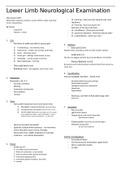Lower Limb Neurological Examination
May present with:
Altered gait, weakness, paralysis, sensory deficits, ataxia, posturing, - L2 = bent leg, “pull your knee towards your nose"
tremor, paraesthesia Hip flexors
- L3 = bent leg, “kick your leg for me”
W.I.P.E.E Extension of the leg at the knee
- Lying down - L4 = dorsiflexion, “bend your foot back”
- Exposure = shorts
- L5 = great toe extension, “bend your big toe back”
- S1 = plantarflexion, “point your toes”
1. Gait
- Ask them to walk normally to assess gait
5. Reflexes
1) Trendelenburg – one-sided hip drop - Knee jerk (l3/l4)
2) Parkinsonian – shuffle, slow turning, small steps Patella tendon, prop leg up under arm like snooker position
3) Ataxic – wide base stance
4) Scissor gait – stiff legs, knock-kneed, on toes - Ankle jerk (s1)
Sit half cross-legged, pull their foot into dorsiflexion, hit Achilles
5) Hemiplegic – one leg swings around hip
6) High-stepping gait - marching - Plantar/Babinski (s1/s2)
Run pointy end of reflex hammer up lateral side of foot and across
- Then walk heel to toe under toes
- Romberg’s test – feet together, eyes closed, 1min
6. Coordination
Test of cerebellar function – D.A.N.I.S.H.
2. Inspection
Remember S.W.I.F.T! Dysdiadochokineasia (past pointing)
- Scarring, symmetry Ataxia (wide base gait)
- Wasting Nystagmus (lateral eye movement)
Hypertonia
- Involuntary movements
Hyperreflexia
- Fasciculations
- Tremors
- Stand up, run heel of foot down opp. shin
(both feet)
3. Tone
- Have patient lying down and move leg for them
1) Roll patient’s leg and watch foot (want foot floppy) 7. Sensation
2) Lift leg at knee joint quickly (want foot stay on bed) - Pain (neurotip)
3) Test for ankle clonus (flex knee slightly and carry weight - Light touch (cotton)
of leg, dorsiflex fort rapidly – keep in this position – clonus =
rhythmical beats of dorsi/plantarflexion; >5 = abnormal)
- Temperature (cold metal tuning fork)
Spinothalamic pathway
- Proprioception (close eyes and move finger)
- Normal, increased, decreased? - Vibration (tuning fork)
- Spasticity (clasped knife resistance – no movement Dorsal column pathway
at first then gives way to force), flaccidity
(decreased tone), rigidity (cogwheel or lead-pipe
resistance – not velocity dependent)
Further investigations
- Full medical history
- Full neurovascular examination upper/lower
4. Power - Nerve conduction studies
- Grade out of 5 - CT/MRI
0 = no visible muscle contraction
1 = flicker of contraction, no movement
2 = joint movement when gravity eliminated
3 = movement against gravity
4 = movement against resistance, but weak
5 = normal




